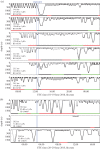Northern bottlenose whales in a pristine environment respond strongly to close and distant navy sonar signals
- PMID: 30890101
- PMCID: PMC6452067
- DOI: 10.1098/rspb.2018.2592
Northern bottlenose whales in a pristine environment respond strongly to close and distant navy sonar signals
Abstract
Impact assessments for sonar operations typically use received sound levels to predict behavioural disturbance in marine mammals. However, there are indications that cetaceans may learn to associate exposures from distant sound sources with lower perceived risk. To investigate the roles of source distance and received level in an area without frequent sonar activity, we conducted multi-scale controlled exposure experiments ( n = 3) with 12 northern bottlenose whales near Jan Mayen, Norway. Animals were tagged with high-resolution archival tags ( n = 1 per experiment) or medium-resolution satellite tags ( n = 9 in total) and subsequently exposed to sonar. We also deployed bottom-moored recorders to acoustically monitor for whales in the exposed area. Tagged whales initiated avoidance of the sound source over a wide range of distances (0.8-28 km), with responses characteristic of beaked whales. Both onset and intensity of response were better predicted by received sound pressure level (SPL) than by source distance. Avoidance threshold SPLs estimated for each whale ranged from 117-126 dB re 1 µPa, comparable to those of other tagged beaked whales. In this pristine underwater acoustic environment, we found no indication that the source distances tested in our experiments modulated the behavioural effects of sonar, as has been suggested for locations where whales are frequently exposed to sonar.
Keywords: Hyperoodon ampullatus; cetacean; disturbance; marine mammal; military sonar.
Conflict of interest statement
We declare we have no competing interests.
Figures




Similar articles
-
Predicting acoustic dose associated with marine mammal behavioural responses to sound as detected with fixed acoustic recorders and satellite tags.J Acoust Soc Am. 2019 Mar;145(3):1401. doi: 10.1121/1.5093543. J Acoust Soc Am. 2019. PMID: 31067938
-
First direct measurements of behavioural responses by Cuvier's beaked whales to mid-frequency active sonar.Biol Lett. 2013 Jul 3;9(4):20130223. doi: 10.1098/rsbl.2013.0223. Print 2013 Aug 23. Biol Lett. 2013. PMID: 23825085 Free PMC article.
-
Beaked whales respond to simulated and actual navy sonar.PLoS One. 2011 Mar 14;6(3):e17009. doi: 10.1371/journal.pone.0017009. PLoS One. 2011. PMID: 21423729 Free PMC article.
-
Active sonar, beaked whales and European regional policy.Mar Pollut Bull. 2011;63(1-4):27-34. doi: 10.1016/j.marpolbul.2010.03.034. Epub 2010 May 6. Mar Pollut Bull. 2011. PMID: 20451221 Review.
-
Ocean Noise and Marine Mammals.Washington (DC): National Academies Press (US); 2003. Washington (DC): National Academies Press (US); 2003. PMID: 25057640 Free Books & Documents. Review.
Cited by
-
Behavioral responses to predatory sounds predict sensitivity of cetaceans to anthropogenic noise within a soundscape of fear.Proc Natl Acad Sci U S A. 2022 Mar 29;119(13):e2114932119. doi: 10.1073/pnas.2114932119. Epub 2022 Mar 21. Proc Natl Acad Sci U S A. 2022. PMID: 35312354 Free PMC article.
-
Co-occurrence of beaked whale strandings and naval sonar in the Mariana Islands, Western Pacific.Proc Biol Sci. 2020 Feb 26;287(1921):20200070. doi: 10.1098/rspb.2020.0070. Epub 2020 Feb 19. Proc Biol Sci. 2020. PMID: 32070257 Free PMC article.
-
Exposure and response of satellite-tagged Blainville's beaked whales to mid-frequency active sonar off Kaua'i, Hawai'i.Mov Ecol. 2025 Apr 21;13(1):29. doi: 10.1186/s40462-025-00550-9. Mov Ecol. 2025. PMID: 40254575 Free PMC article.
-
Long-Term Depth Records of Satellite-Tagged Northern Bottlenose Whales Reveal Extraordinary Dive Capabilities.Ecol Evol. 2025 Jul 30;15(8):e71862. doi: 10.1002/ece3.71862. eCollection 2025 Aug. Ecol Evol. 2025. PMID: 40740810 Free PMC article.
-
Genomics reveal population structure, evolutionary history, and signatures of selection in the northern bottlenose whale, Hyperoodon ampullatus.Mol Ecol. 2022 Oct;31(19):4919-4931. doi: 10.1111/mec.16643. Epub 2022 Aug 23. Mol Ecol. 2022. PMID: 35947506 Free PMC article.
References
-
- Heide-Jørgensen MP, Hansen RG, Westdal K, Reeves RR, Mosbech A. 2013. Narwhals and seismic exploration: is seismic noise increasing the risk of ice entrapments? Biol. Conserv. 158, 50–54. (10.1016/j.biocon.2012.08.005) - DOI
-
- Miller PJO, et al. 2012. The severity of behavioral changes observed during experimental exposures of killer (Orcinus orca), long-finned pilot (Globicephala melas), and sperm (Physeter macrocephalus) whales to naval sonar. Aquat. Mamm. 38, 362–401. (10.1578/AM.38.4.2012.362) - DOI
-
- Ocean Studies Board. 2017. Approaches to understanding the cumulative effects of stressors on marine mammals. Washington, DC: National Academies Press; (10.17226/23479) - DOI
Publication types
MeSH terms
Associated data
LinkOut - more resources
Full Text Sources
Other Literature Sources
Medical
Miscellaneous

